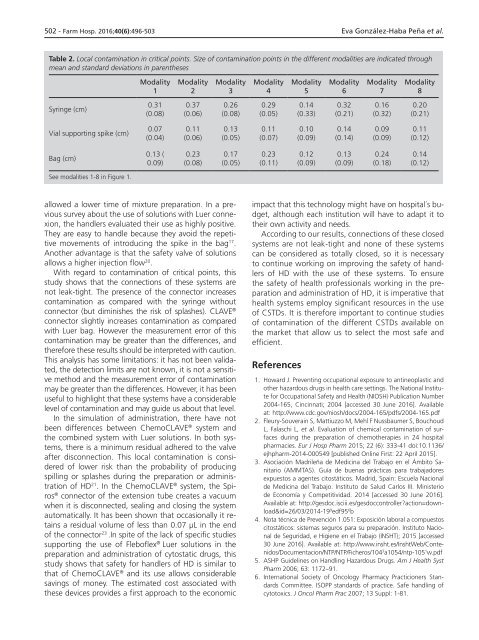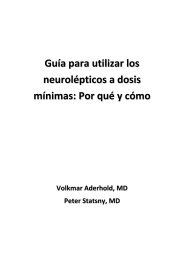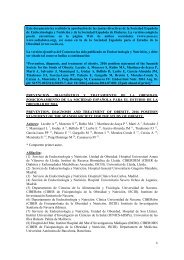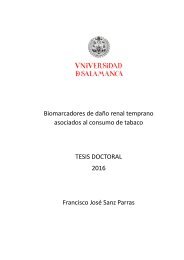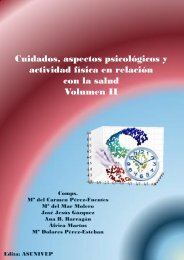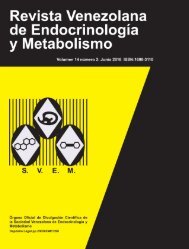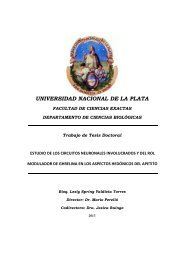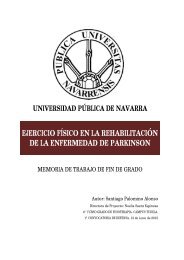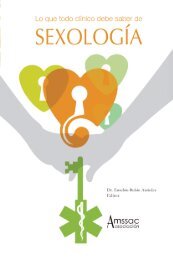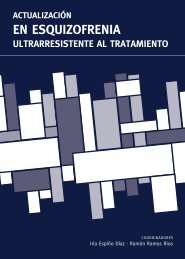Noviembre-Diciembre
156_v40n6(1)
156_v40n6(1)
Create successful ePaper yourself
Turn your PDF publications into a flip-book with our unique Google optimized e-Paper software.
502 - Farm Hosp. 2016;40(6):496-503 Eva González-Haba Peña et al.<br />
Table 2. Local contamination in critical points. Size of contamination points in the different modalities are indicated through<br />
mean and standard deviations in parentheses<br />
Modality<br />
1<br />
Modality<br />
2<br />
Modality<br />
3<br />
Modality<br />
4<br />
Modality<br />
5<br />
Modality<br />
6<br />
Modality<br />
7<br />
Modality<br />
8<br />
Syringe (cm)<br />
0.31<br />
(0.08)<br />
0.37<br />
(0.06)<br />
0.26<br />
(0.08)<br />
0.29<br />
(0.05)<br />
0.14<br />
(0.33)<br />
0.32<br />
(0.21)<br />
0.16<br />
(0.32)<br />
0.20<br />
(0.21)<br />
Vial supporting spike (cm)<br />
0.07<br />
(0.04)<br />
0.11<br />
(0.06)<br />
0.13<br />
(0.05)<br />
0.11<br />
(0.07)<br />
0.10<br />
(0.09)<br />
0.14<br />
(0.14)<br />
0.09<br />
(0.09)<br />
0.11<br />
(0.12)<br />
Bag (cm)<br />
0.13 (<br />
0.09)<br />
0.23<br />
(0.08)<br />
0.17<br />
(0.05)<br />
0.23<br />
(0.11)<br />
0.12<br />
(0.09)<br />
0.13<br />
(0.09)<br />
0.24<br />
(0.18)<br />
0.14<br />
(0.12)<br />
See modalities 1-8 in Figure 1.<br />
allowed a lower time of mixture preparation. In a previous<br />
survey about the use of solutions with Luer connexion,<br />
the handlers evaluated their use as highly positive.<br />
They are easy to handle because they avoid the repetitive<br />
movements of introducing the spike in the bag 17 .<br />
Another advantage is that the safety valve of solutions<br />
allows a higher injection flow 20 .<br />
With regard to contamination of critical points, this<br />
study shows that the connections of these systems are<br />
not leak-tight. The presence of the connector increases<br />
contamination as compared with the syringe without<br />
connector (but diminishes the risk of splashes). CLAVE ®<br />
connector slightly increases contamination as compared<br />
with Luer bag. However the measurement error of this<br />
contamination may be greater than the differences, and<br />
therefore these results should be interpreted with caution.<br />
This analysis has some limitations: it has not been validated,<br />
the detection limits are not known, it is not a sensitive<br />
method and the measurement error of contamination<br />
may be greater than the differences. However, it has been<br />
useful to highlight that these systems have a considerable<br />
level of contamination and may guide us about that level.<br />
In the simulation of administration, there have not<br />
been differences between ChemoCLAVE ® system and<br />
the combined system with Luer solutions. In both systems,<br />
there is a minimum residual adhered to the valve<br />
after disconnection. This local contamination is considered<br />
of lower risk than the probability of producing<br />
spilling or splashes during the preparation or administration<br />
of HD 21 . In the ChemoCLAVE ® system, the Spiros<br />
® connector of the extension tube creates a vacuum<br />
when it is disconnected, sealing and closing the system<br />
automatically. It has been shown that occasionally it retains<br />
a residual volume of less than 0.07 µL in the end<br />
of the connector 23 .In spite of the lack of specific studies<br />
supporting the use of Fleboflex ® Luer solutions in the<br />
preparation and administration of cytostatic drugs, this<br />
study shows that safety for handlers of HD is similar to<br />
that of ChemoCLAVE ® and its use allows considerable<br />
savings of money. The estimated cost associated with<br />
these devices provides a first approach to the economic<br />
impact that this technology might have on hospital´s budget,<br />
although each institution will have to adapt it to<br />
their own activity and needs.<br />
According to our results, connections of these closed<br />
systems are not leak-tight and none of these systems<br />
can be considered as totally closed, so it is necessary<br />
to continue working on improving the safety of handlers<br />
of HD with the use of these systems. To ensure<br />
the safety of health professionals working in the preparation<br />
and administration of HD, it is imperative that<br />
health systems employ significant resources in the use<br />
of CSTDs. It is therefore important to continue studies<br />
of contamination of the different CSTDs available on<br />
the market that allow us to select the most safe and<br />
efficient.<br />
References<br />
1. Howard J. Preventing occupational exposure to antineoplastic and<br />
other hazardous drugs in health care settings. The National Institute<br />
for Occupational Safety and Health (NIOSH) Publication Number<br />
2004-165, Cincinnati; 2004 [accessed 30 June 2016]. Available<br />
at: http://www.cdc.gov/niosh/docs/2004-165/pdfs/2004-165.pdf<br />
2. Fleury-Souverain S, Mattiuzzo M, Mehl F Nussbaumer S, Bouchoud<br />
L, Falaschi L, et al. Evaluation of chemical contamination of surfaces<br />
during the preparation of chemotherapies in 24 hospital<br />
pharmacies. Eur J Hosp Pharm 2015; 22 (6): 333-41 doi:10.1136/<br />
ejhpharm-2014-000549 [published Online First: 22 April 2015].<br />
3. Asociación Madrileña de Medicina del Trabajo en el Ámbito Sanitario<br />
(AMMTAS). Guía de buenas prácticas para trabajadores<br />
expuestos a agentes citostáticos. Madrid, Spain: Escuela Nacional<br />
de Medicina del Trabajo. Instituto de Salud Carlos III. Ministerio<br />
de Economía y Competitividad. 2014 [accessed 30 June 2016].<br />
Available at: http://gesdoc.isciii.es/gesdoccontroller?action=download&id=26/03/2014-19<br />
9 edf95 6 b<br />
4. Nota técnica de Prevención 1.051: Exposición laboral a compuestos<br />
citostáticos: sistemas seguros para su preparación. Instituto Nacional<br />
de Seguridad, e Higiene en el Trabajo (INSHT); 2015 [accessed<br />
30 June 2016]. Available at: http://www.insht.es/InshtWeb/Contenidos/Documentacion/NTP/NTP/Ficheros/104<br />
3 a1054/ntp-105 1 w.pdf<br />
5. ASHP Guidelines on Handling Hazardous Drugs. Am J Health Syst<br />
Pharm 2006; 63: 1172–91.<br />
6. International Society of Oncology Pharmacy Practicioners Standards<br />
Committee. ISOPP standards of practice. Safe handling of<br />
cytotoxics. J Oncol Pharm Prac 2007; 13 Suppl: 1-81.


